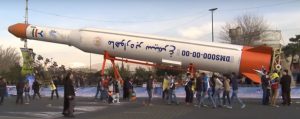More details are emerging of Iran’s launch of its Simorgh missile on Tuesday, 19 April, 2016.

Most experts are unable to agree whether it was a failed space launch or a successful test of a new booster stage, with a few analysts are now suggesting that the Simorgh launch was in fact a test of a third-stage booster. If this is the case then it suggests that Iran is making progress in developing Simorgh as both a space-launch vehicle and also as an intercontinental ballistic missile (ICBM).
US officials and politicians condemned the 19 April launch as further evidence that Tehran is determined to develop a functioning ICBM – a long-range missile – in order to threaten to strike the United States. Further, many in Washington believe that the only reason for Iran to continue its efforts to develop ICBM’s is so that it can put nuclear warheads on them, despite the recent agreement between Iran and other powers that seeks to dismantle Tehran’s nuclear programme.
Senator Tom Cotton, a Republican representing the state of Arkansas, told the Washington Free Beacon newspaper, that, “An Iranian Simorgh space launch vehicle test would be a provocation of the highest order and shows Iran’s true intentions. The [US] intelligence community has said publicly that this [space launch vehicle] technology would aid an Iranian [intercontinental ballistic missile] program. And the only reason one develops ICBMs is the delivery of nuclear weapons.”
Dr. Laura Grego of the Union of Concerned Scientists think-tank based in Cambridge, Massachusetts, disagrees, stating to the Washington Free Beacon that, “As far as I can tell, Iran does not tend to acknowledge failures. The Simorgh appears designed specifically as a satellite launcher, not as a ballistic missile, although some of the technology used in it could be used for a ballistic missile.”
The 19 April launch took place from the Semnan space launch centre, also known as the Imam Khomeini Space Centre, approximately 200 kilometers east of Tehran. The missile did not enter Earth orbit, and apparently landed in the southern part of Iran.
A number of analysts now believe that the launch was in fact a successful test of one of the Simorgh’s boosters, and not an intended launch of a satellite that failed. Further, it is very hard to distinguish between Simorgh’s role as a space-launch vehicle or as an ICBM, since both functions use the same technologies.
Many governments around the world believe that the development of Simorgh as a space-launch vehicle is in fact a cover for Iran’s ICBM programme, though Iran does have an active space agency.
 SpaceWatch.Global An independent perspective on space
SpaceWatch.Global An independent perspective on space

